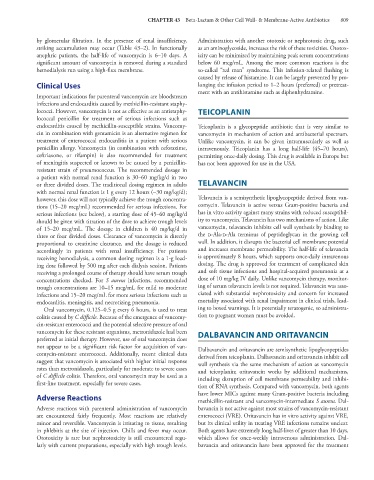Page 823 - Basic _ Clinical Pharmacology ( PDFDrive )
P. 823
CHAPTER 43 Beta-Lactam & Other Cell Wall- & Membrane-Active Antibiotics 809
by glomerular filtration. In the presence of renal insufficiency, Administration with another ototoxic or nephrotoxic drug, such
striking accumulation may occur (Table 43–2). In functionally as an aminoglycoside, increases the risk of these toxicities. Ototox-
anephric patients, the half-life of vancomycin is 6–10 days. A icity can be minimized by maintaining peak serum concentrations
significant amount of vancomycin is removed during a standard below 60 mcg/mL. Among the more common reactions is the
hemodialysis run using a high-flux membrane. so-called “red man” syndrome. This infusion-related flushing is
caused by release of histamine. It can be largely prevented by pro-
Clinical Uses longing the infusion period to 1–2 hours (preferred) or pretreat-
ment with an antihistamine such as diphenhydramine.
Important indications for parenteral vancomycin are bloodstream
infections and endocarditis caused by methicillin-resistant staphy-
lococci. However, vancomycin is not as effective as an antistaphy- TEICOPLANIN
lococcal penicillin for treatment of serious infections such as
endocarditis caused by methicillin-susceptible strains. Vancomy- Teicoplanin is a glycopeptide antibiotic that is very similar to
cin in combination with gentamicin is an alternative regimen for vancomycin in mechanism of action and antibacterial spectrum.
treatment of enterococcal endocarditis in a patient with serious Unlike vancomycin, it can be given intramuscularly as well as
penicillin allergy. Vancomycin (in combination with cefotaxime, intravenously. Teicoplanin has a long half-life (45–70 hours),
ceftriaxone, or rifampin) is also recommended for treatment permitting once-daily dosing. This drug is available in Europe but
of meningitis suspected or known to be caused by a penicillin- has not been approved for use in the USA.
resistant strain of pneumococcus. The recommended dosage in
a patient with normal renal function is 30–60 mg/kg/d in two
or three divided doses. The traditional dosing regimen in adults TELAVANCIN
with normal renal function is 1 g every 12 hours (~30 mg/kg/d);
however, this dose will not typically achieve the trough concentra- Telavancin is a semisynthetic lipoglycopeptide derived from van-
tions (15–20 mcg/mL) recommended for serious infections. For comycin. Telavancin is active versus Gram-positive bacteria and
serious infections (see below), a starting dose of 45–60 mg/kg/d has in vitro activity against many strains with reduced susceptibil-
should be given with titration of the dose to achieve trough levels ity to vancomycin. Telavancin has two mechanisms of action. Like
of 15–20 mcg/mL. The dosage in children is 40 mg/kg/d in vancomycin, telavancin inhibits cell wall synthesis by binding to
three or four divided doses. Clearance of vancomycin is directly the d-Ala-d-Ala terminus of peptidoglycan in the growing cell
proportional to creatinine clearance, and the dosage is reduced wall. In addition, it disrupts the bacterial cell membrane potential
accordingly in patients with renal insufficiency. For patients and increases membrane permeability. The half-life of telavancin
receiving hemodialysis, a common dosing regimen is a 1-g load- is approximately 8 hours, which supports once-daily intravenous
ing dose followed by 500 mg after each dialysis session. Patients dosing. The drug is approved for treatment of complicated skin
receiving a prolonged course of therapy should have serum trough and soft tissue infections and hospital-acquired pneumonia at a
concentrations checked. For S aureus infections, recommended dose of 10 mg/kg IV daily. Unlike vancomycin therapy, monitor-
trough concentrations are 10–15 mcg/mL for mild to moderate ing of serum telavancin levels is not required. Telavancin was asso-
infections and 15–20 mcg/mL for more serious infections such as ciated with substantial nephrotoxicity and concern for increased
endocarditis, meningitis, and necrotizing pneumonia. mortality associated with renal impairment in clinical trials, lead-
Oral vancomycin, 0.125–0.5 g every 6 hours, is used to treat ing to boxed warnings. It is potentially teratogenic, so administra-
colitis caused by C difficile. Because of the emergence of vancomy- tion to pregnant women must be avoided.
cin-resistant enterococci and the potential selective pressure of oral
vancomycin for these resistant organisms, metronidazole had been DALBAVANCIN AND ORITAVANCIN
preferred as initial therapy. However, use of oral vancomycin does
not appear to be a significant risk factor for acquisition of van- Dalbavancin and oritavancin are semisynthetic lipoglycopeptides
comycin-resistant enterococci. Additionally, recent clinical data derived from teicoplanin. Dalbavancin and oritavancin inhibit cell
suggest that vancomycin is associated with higher initial response wall synthesis via the same mechanism of action as vancomycin
rates than metronidazole, particularly for moderate to severe cases and teicoplanin; oritavancin works by additional mechanisms,
of C difficile colitis. Therefore, oral vancomycin may be used as a including disruption of cell membrane permeability and inhibi-
first-line treatment, especially for severe cases.
tion of RNA synthesis. Compared with vancomycin, both agents
Adverse Reactions have lower MICs against many Gram-positive bacteria including
methicillin-resistant and vancomycin-intermediate S aureus. Dal-
Adverse reactions with parenteral administration of vancomycin bavancin is not active against most strains of vancomycin-resistant
are encountered fairly frequently. Most reactions are relatively enterococci (VRE). Oritavancin has in vitro activity against VRE,
minor and reversible. Vancomycin is irritating to tissue, resulting but its clinical utility in treating VRE infections remains unclear.
in phlebitis at the site of injection. Chills and fever may occur. Both agents have extremely long half-lives of greater than 10 days,
Ototoxicity is rare but nephrotoxicity is still encountered regu- which allows for once-weekly intravenous administration. Dal-
larly with current preparations, especially with high trough levels. bavancin and oritavancin have been approved for the treatment

